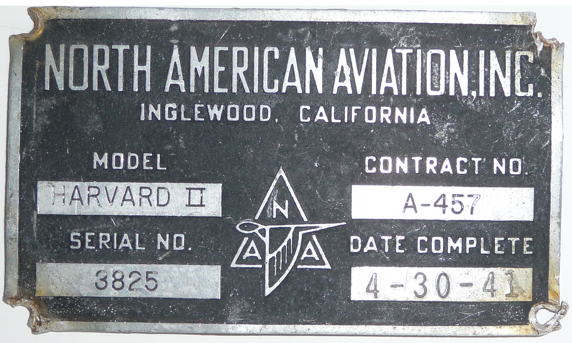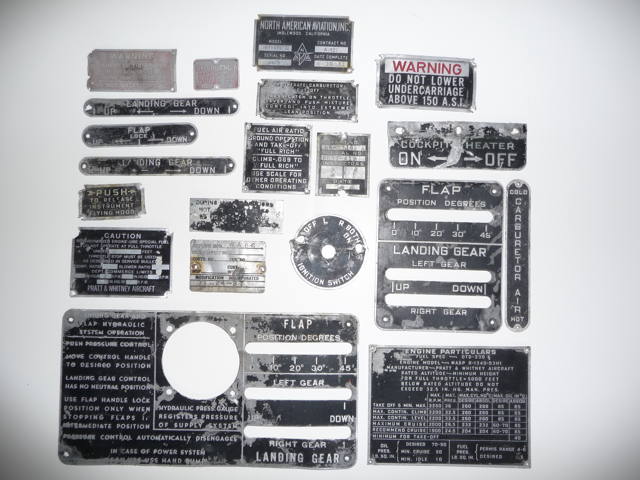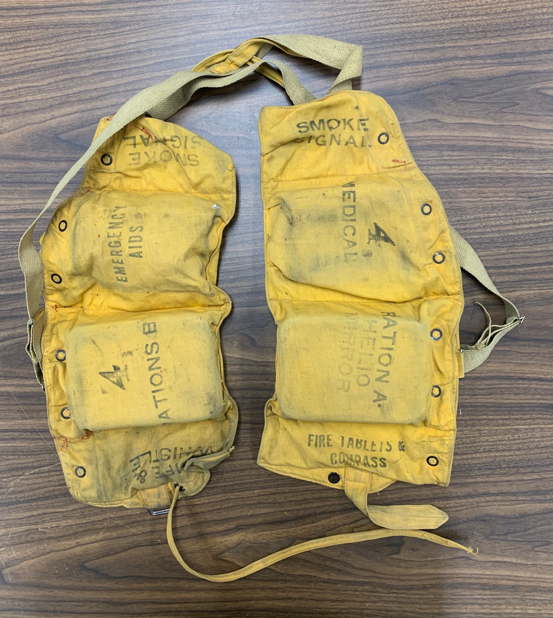 Museum
Museum  |
Bomber Command
|
Aircrew Chronicles
|
Aircrew Losses
|
Nose Art
|
BCATP
|
Lancaster
|
Media
|
Bomber Command
|
Aircrew Chronicles
|
Aircrew Losses
|
Nose Art
|
BCATP
|
Lancaster
|
Media
 Museum
Museum  |
Bomber Command
|
Aircrew Chronicles
|
Aircrew Losses
|
Nose Art
|
BCATP
|
Lancaster
|
Media
|
Bomber Command
|
Aircrew Chronicles
|
Aircrew Losses
|
Nose Art
|
BCATP
|
Lancaster
|
Media
Bomber Command Museum Chronicles
The crash of Harvard #3825 and subsequent deaths of the two airmen aboard is a complex story that is still not completely clear. As well as the two airmen it involved a hunter, an RCMP rescue party, and three ranchers. What is clear is that the aircraft crashed near the summit of the Bull Creek Hills, on the steep, north-facing slopes at the head of Deep Creek that flows to the east from near the summit. The Bull Creek Hills lie four kilometres east of Holy Cross Mountain, immediately north of the Highwood Valley northwest of the entrance to Kananaskis Country. They reach an elevation of 2179 metres. The following information begins with an account written by Dorothy Reimer. This is followed by additional information received from Peter Diebel, whose father played a crucial role in the rescue. |
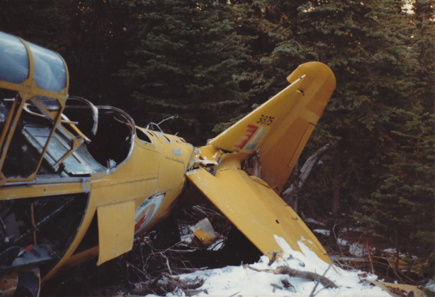 |
It was 3:04 pm, Tuesday, December 11, 1951, a good forecast and clear sunny weather, when three R.C.A.F. Harvard Trainer planes left Medicine Hat bound for Calgary. But the sunshine soon gave way to cloud and semi-blizzard conditions. As they approached Calgary, the ceiling had dropped to ground level. Instructions to divert to Claresholm were issued. Two landed safely. The third Trainer vanished.
In the missing plane were pilot Flying Officer Cyril Douglas Wilken from Redvers, Sask., and mechanic Corporal Clifford Johnson from Canterbury, N.B. Flying with barely 15 yards visibility and no idea where they were, they suddenly saw a mountain looming in front. Desperately, Wilken tried to climb but the plane stalled and crashed violently on the steep hillside, coming to rest at a 45 degree angle, wedged against some trees. Wings and parts of the fuselage and tail section were ripped away. Johnson was thrown clear but Wilken was trapped in the cockpit. It was 4:30 pm, very cold, snowing, and already dark. It would be 2 days before Johnson found help and another 14 hours before searchers would reach Wilken.
The site of this tragedy was the Bull Creek Hills, that high range of hills east of Holy Cross Mountain and Mount Head. The search and rescue operation was headline news in The Albertan newspaper for days. Until the early '90s, some of the remains of the Trainer lay back in the brush and trees only a few hundred meters off one of today's popular hiking trails, a traverse from Marston Creek to Grass Pass near the eastern Kananaskis Country boundary, 30 km southwest of Longview.
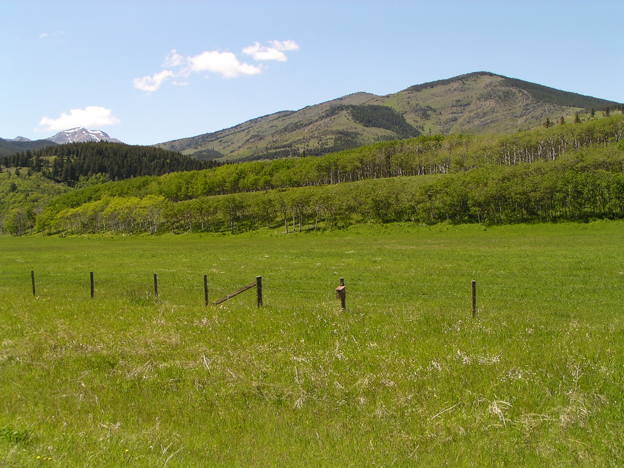
Johnson's account of the aftermath of the crash is gripping to read. Unconscious for the first 1-1/2 hours, when he came to he feared making a fire because it might burn the plane where Wilken lay. After a time he thought he heard search planes. In fact, the continuous drone of engines came from an oil rig in nearby Trap Creek where Canadian New Delhi #1 was drilling but the mechanic never knew this. Disoriented and confused, he didn't realize that planes would not be searching at night in a storm.
Throughout Wednesday, Johnson tried to free Wilken but without tools to cut into the cockpit he finally had to give up. Another 30 cm of snow fell overnight. Wilken was becoming delirious and Johnson decided to try to walk out. As he said, while he might die looking for help, it was no worse than dying by the downed plane. He left before daylight, Thursday, around 6 am., struggling through thigh-deep snow. The clouds had lifted but it was still very cold. Shortly after noon, he encountered Ray Beagle, out hunting in the hills. Beagle took him back to his camp and from there they travelled out to the Stampede Ranch to alert the searchers.
A rescue team set out from Stampede Ranch Thursday at 5:30 pm. Johnson didn't know where the wreck was and the team had to find his tracks and backtrack. Dave Diebel, who ranched just south of the present highway, set out on horseback with one of his hands, Charlie Williams, to intercept the team and it was he who found the crash site at 2:30 Friday morning.
Wilken was freed and brought out on a stretcher to the Stampede Ranch and from there he was airlifted to Calgary to the Colonel Belcher hospital. Feet and hands were frozen. Doctors worked to thaw his extremities but by Monday they found that there were internal injuries as well and his condition was given as "seriously ill". Sadly, he died Wednesday morning, his wife at his bedside.
For over 25 years the remains of the Harvard Trainer lay untouched at the original site. Then in the '80s, they were dragged further out of the bush. Finally, in the early '90s, someone went in and scavenged the last of the brilliant yellow fuselage and wings. Today, nothing is left to remind us of the tragedy and heroism of those men who lived this story.
Next time you near the summit on a hike in the Bull Creek Hills, look around and imagine a meter of snow and bitter cold temperatures. Take a moment to remember.
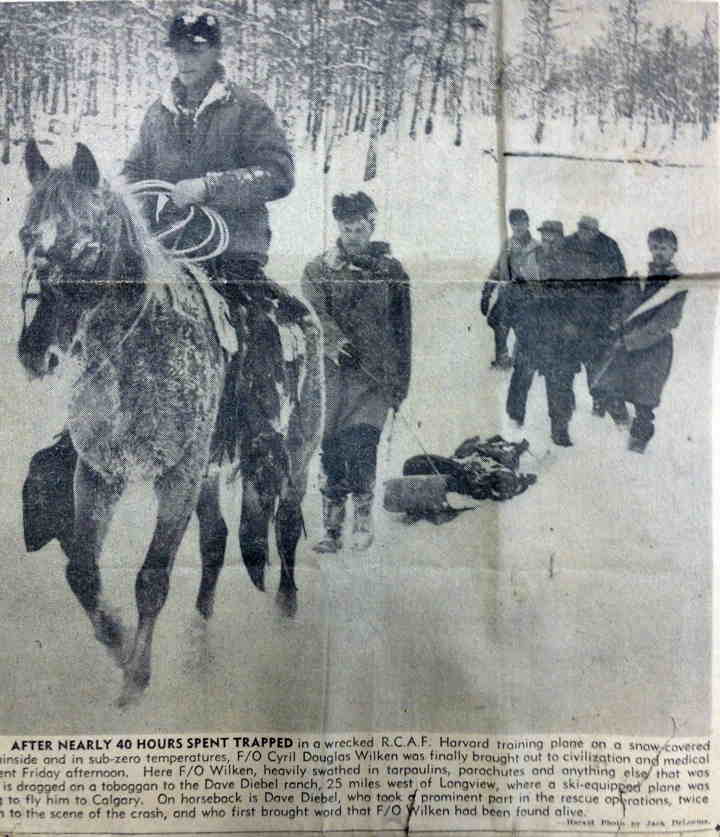
Cpl. Johnson started walking out about four hours after the crash after determining that he could not free his trapped pilot. Hopelessly lost and disoriented, he descended Deep Creek and then, headed north towards Trap Creek where, after walking through the deep snow all night, he was found by the hunter (Ray Beagle). Together, they made their way to the Stampede Ranch from which the police and the RCAF were notified.
 |
Cliff Rawthorne called on Dave Diebel and Charlie Williams to try to find the crash site and hopefully rescue F/O Wilken. They rode on horseback, north across lower east-facing slopes of the Bull Creek Hills where they encountered Cpl. Johnson's tracks as they reached Deep Creek. They then climbed the steep valley to the crash site. Shortly after Dave and Charlie had left the Stampede Ranch, a group of four RCMP officers arrived and set out on foot for the crash site with Cliff Rawthorne, following Dave and Charlie's tracks. Although well-intentioned, the Mounties were very poorly equipped, wearing leather boots and not prepared at all to rescue an injured pilot from a high-elevation crash site in the middle of winter. When the Mounties reached the site, one of them was in such bad shape that Dave determined that he was the one who was most in need of rescue. Dave put him on Charlie's horse (Nellie) and took him back down to the ranch first. Peter, Dave's son, remembers how difficult it was to get the man off the horse at the house because he was so sore and cold. An air force doctor was at the ranch house by this time, and he rode Charlie's horse back to the crash site with Dave. When they arrived, the Doctor did what he could but said he could do little to help the pilot there and that they needed to get him out as soon as possible. The pilot was placed on a toboggan and Dave and Charlie Williams rode back and the doctor and the remaining three Mounties walked, helping with the toboggan. Peter remembers that when they finally reached the Highwood Valley there were lots of air force personnel, police, reporters, and others lining the road. |
